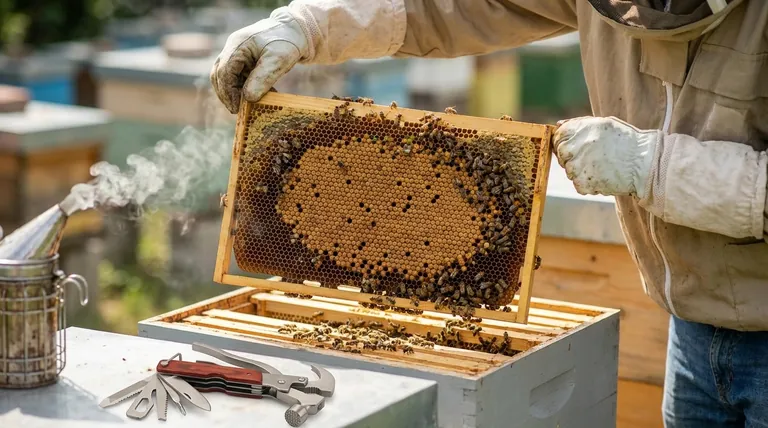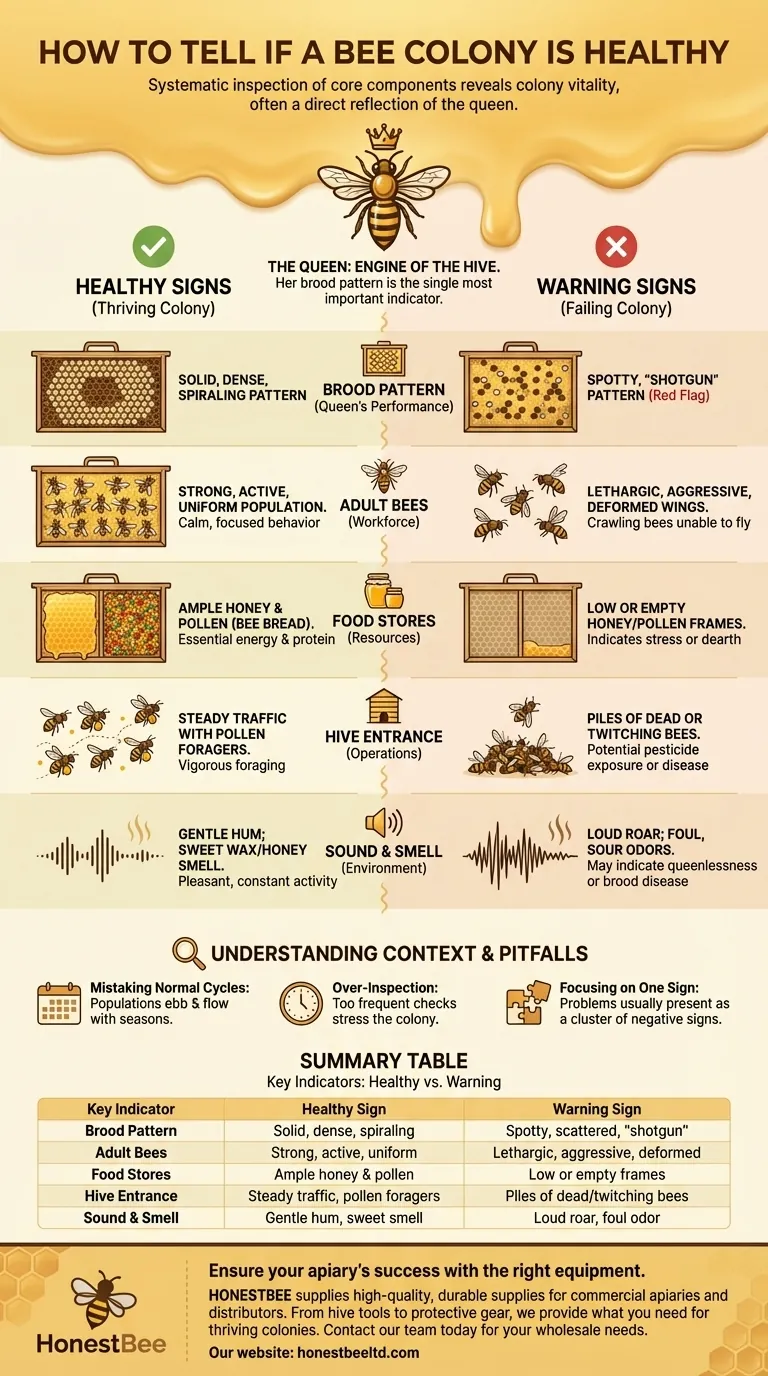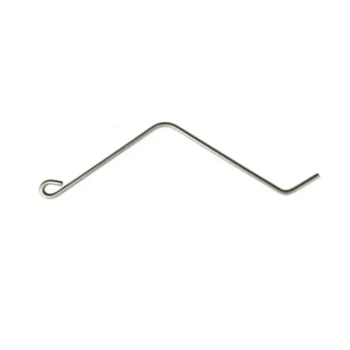To determine if a bee colony is healthy, you must perform a systematic inspection of its core components. The most reliable indicators are a consistent and dense brood pattern laid by the queen, a strong and active population of uniform adult bees, and sufficient food stores of honey and pollen for the colony's size. Observing the hive's entrance, weight, sound, and smell provides additional critical data points.
The health of a honeybee colony is a direct reflection of its queen. While many factors contribute to hive vitality, the quality and pattern of the brood she lays is the single most important indicator of a thriving, productive, and stable colony.

The Queen as the Engine of the Hive
A colony's entire future rests on the queen's ability to lay a continuous supply of healthy offspring. Evaluating her performance is the primary goal of any hive inspection.
What a "Tight Brood Pattern" Reveals
A productive, well-mated queen will lay her eggs in a compact, spiraling pattern. When you pull a frame from the center of the brood nest, you should see a solid, concentrated block of sealed pupae, often called capped brood.
This dense pattern indicates the queen is fertile and laying consistently, cell by cell, without skipping around. Surrounding this capped brood, you should find a ring of younger larvae and then eggs in the outer cells, showing a logical progression.
Identifying a "Spotty" or Failing Queen
A failing queen, poor mating, or underlying disease will result in a spotty or "shotgun" brood pattern. Instead of a solid block, you will see capped brood cells scattered randomly with many empty cells in between.
This is a significant red flag. It means the queen is either infertile, running out of sperm, or the nurse bees are removing diseased or unviable larvae before they can be capped.
Assessing the Workforce: The Adult Bees
The adult bee population is the colony's current labor force. Their health, behavior, and numbers tell you about the hive's present condition and ability to function.
Population Density and Demeanor
A healthy hive should be visibly full of bees. When you open the hive, the tops of the frames should be covered, and the spaces between frames should be packed with bees, often described as "boiling with bees."
Their behavior is also telling. A healthy hive is typically calm and focused on its work. Excessive aggression or lethargy can be a sign of stress, queenlessness, or disease.
Uniformity and Physical Health
Observe the bees themselves. They should be relatively uniform in size and appearance. Look closely for tattered or deformed wings, which is a classic symptom of viral issues often spread by the Varroa mite.
A large number of crawling bees unable to fly near the hive entrance is another indicator of a serious health problem.
Evaluating the Hive's Resources and Defenses
A strong colony is not just about population; it's also about the resources it has gathered and its ability to defend them.
Checking Food Stores
A colony needs honey (carbohydrates for energy) and pollen (protein for raising brood). A healthy hive will have frames of stored honey, typically in the upper boxes and on the outside of the brood nest.
You should also see cells filled with colorful packed pollen, known as "bee bread," near the brood. A lack of either resource, especially during a nectar dearth, can put the entire colony under stress.
The Story at the Entrance
The hive entrance is a window into its daily operations. A steady stream of bees flying in and out, with many returning with bright balls of pollen on their legs, is a sign of vigorous foraging.
A pile of dead bees can be alarming but is sometimes normal, as undertaker bees remove those that die naturally. However, an excessive number of casualties, especially twitching or crawling bees, signals a problem like pesticide exposure.
Using Sound and Smell
A healthy hive has a pleasant, sweet smell of beeswax and honey. It also emits a constant, low hum of activity. If you put your ear to the side of the hive, you should hear this gentle "purr."
A loud, continuous roar, especially if it persists for days, can indicate the colony is queenless. Any foul or sour odors, like the smell of rotting meat, are an immediate warning sign of severe brood diseases like American Foulbrood.
Understanding Common Pitfalls
Assessing hive health requires context. It's easy for new beekeepers to misinterpret normal cycles or overreact to single data points.
Mistaking Normal Cycles for Problems
A colony's population naturally ebbs and flows with the seasons. A smaller population in early spring or late fall is normal. Likewise, a queen may temporarily stop laying during a nectar dearth to conserve resources.
The Danger of Over-Inspection
Every time you open a hive, you disrupt its temperature and social cohesion, stressing the colony. Inspecting too frequently (more than every 7-10 days) can chill the brood, increase the risk of killing the queen, and set the colony back.
Focusing on One Sign in Isolation
No single observation tells the whole story. A few dead bees at the entrance of a hive that is otherwise booming with a great brood pattern is not a cause for panic. True problems usually present as a cluster of negative signs, such as a spotty brood pattern and a low population and lethargic bees.
A Practical Framework for Your Inspections
Use your observations to build a complete picture of the colony's health, tailoring your focus to the goal of the inspection.
- If your primary focus is a quick check: Look for strong flight activity at the entrance with bees carrying pollen, and confirm the hive feels heavy for its size.
- If your primary focus is a full inspection: Your number one priority is to find frames of brood and confirm the queen is laying in a dense, solid pattern.
- If your primary focus is diagnosing a problem: Look for a combination of negative indicators, especially a poor brood pattern, lethargic or deformed bees, and any unusual smells.
True confidence in beekeeping comes from consistently observing your hives and learning to recognize the patterns of a healthy, functioning superorganism.
Summary Table:
| Key Indicator | Healthy Sign | Warning Sign |
|---|---|---|
| Brood Pattern | Solid, dense, spiraling pattern | Spotty, scattered, "shotgun" pattern |
| Adult Bees | Strong, active, uniform population | Lethargic, aggressive, deformed wings |
| Food Stores | Ample honey and pollen (bee bread) | Low or empty honey/pollen frames |
| Hive Entrance | Steady traffic with pollen foragers | Piles of dead or twitching bees |
| Sound & Smell | Gentle hum; sweet wax/honey smell | Loud roar; foul, sour odors |
Ensure your apiary's success with the right equipment. A healthy colony starts with a well-managed hive. HONESTBEE supplies commercial apiaries and beekeeping equipment distributors with high-quality, durable supplies through our wholesale-focused operations. From hive tools to protective gear, we provide the reliable equipment you need to maintain thriving colonies. Contact our team today to discuss your wholesale needs and strengthen your beekeeping operation.
Visual Guide

Related Products
- HONESTBEE 15-in-1 Beekeeper Multi-Tool with Hammer and Pliers for Beekeeping
- Professional Galvanized Hive Strap with Secure Locking Buckle for Beekeeping
- Versatile Ratchet Hive Strap with S-Hooks for Secure Fastening
- Retractable Chinese Queen Rearing Grafting Tools Equipment
- Langstroth Screen Bottom Board for Beekeeping Wholesale
People Also Ask
- Why is it important for beekeepers to be prepared with the necessary tools before the beekeeping season begins? The Key to Proactive Success
- Do bee hives require maintenance? Essential Practices for a Healthy, Productive Colony
- Why is it important to compare the progress of different hives? A Beekeeper's Key Diagnostic Tool
- What are the benefits of a multi-functional hive tool? Streamline Your Apiary Workflow with One Tool
- What should be checked during a hive inspection? A Guide to Assessing Colony Health



















